A product roadmap will guide you through the product management process, which is notoriously known as a detail-oriented discipline. Getting into the weeds is part of the product manager job description, but one should never get lost there. Product managers must use tools such as a product development roadmap to lift their heads out of the day-to-day operations of the product development process to take a larger look at where they are in context.
Product roadmaps are essential to product management because they allow the product manager and anyone involved in the project to see the big picture. We’ve created a product roadmap example and template to explain how they work, but first, let’s define what goes into creating a product roadmap so that it’s as clear and useful as possible for product development.
What Is a Product Roadmap?
A product roadmap is a product development tool that captures the product vision and strategy and serves as a guide for executing that product strategy, while getting internal stakeholders aligned, facilitating discussions around product features, and aiding communication with external stakeholders and customers. It’s all laid out so that everyone in the product development team understands it.
The product roadmap also called the product development roadmap, is the responsibility of the product manager, both to create and to use as a communication tool. This sets the proper expectations while sharing the product overview and highlighting important features to come.
Product managers use software tools like ProjectManager to create product roadmaps. ProjectManager is equipped with Gantt charts, kanban boards, task lists and project calendars to help you create and manage your product roadmap. Get started with ProjectManager for free.

Why Is It Important to Create a Product Roadmap?
Building a product roadmap allows manufacturers to visualize and schedule all the activities that need to be executed to develop, manufacture and launch products to the market.
Product roadmaps are a versatile tool that will help guide the efforts of cross-functional teams, track progress, estimate the costs and duration of tasks and communicate the status of the product development process to stakeholders.
There are various types of product roadmaps to choose from. Each has pros and cons depending on the product planning and work management approach of your organization.
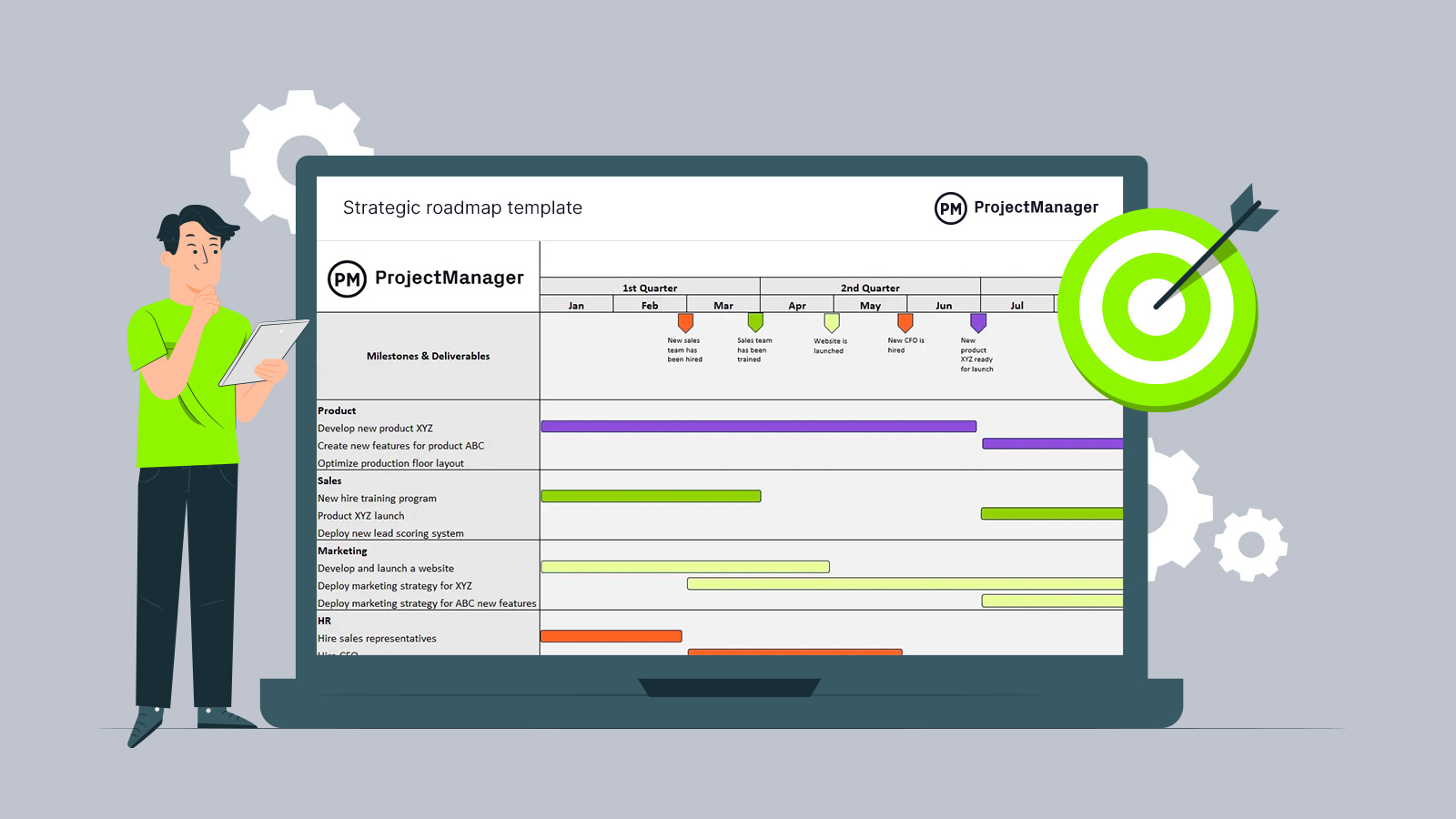
Get your free
Product Roadmap Template
Use this free Product Roadmap Template for Excel to manage your projects better.
Product Roadmap Example
Here’s what a Gantt chart product roadmap example looks like. Gantt charts are a great planning tool that allows product managers to create interactive product roadmaps.
With ProjectManager’s Gantt Charts, you can create product roadmaps to keep track of user stories, epics, resources, your team’s workload and much more!
Below, you can see a product roadmap example in which an organization uses ProjectManager’s Gantt chart to make an interactive product roadmap which allows its product development team to visualize and schedule all the activities required to develop a product, test it to ensure it meets quality and safety standards and launch it into the market.
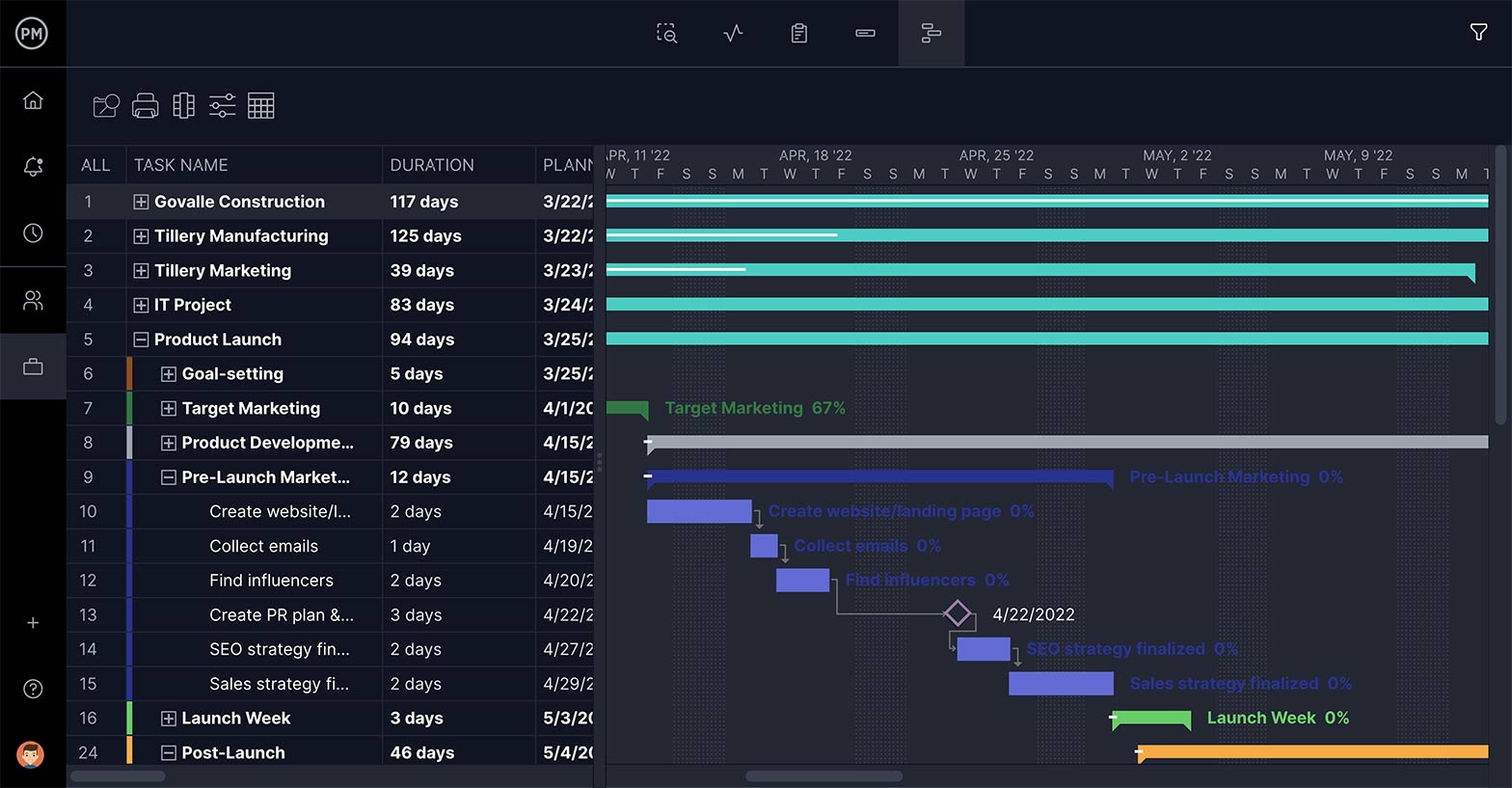
Besides listing tasks and estimating their duration, you can assign them to your team members and ProjectManager’s Gantt chart will automatically calculate labor costs based on the team member’s hourly rate. Also, manually enter other costs for all the tasks, which helps keep track of the budget.
Who Oversees the Process of Creating Product Roadmaps?
In most cases, the product manager is in charge of overseeing the process of making and updating the product roadmap, but due to their importance for the success of a manufacturing company, making the product roadmap should be should be a cross-functional effort that welcomes input from other departments such as marketing, sales, customer service or the executive team.
Each of these departments can provide useful information that could help the product development team better prioritize its efforts in terms of developing the products that will help the company achieve its strategic planning objectives.
What Types of Teams Use Product Roadmaps?
Product roadmaps are especially useful for businesses that develop complex products that take months or years to make, as these require extensive project planning. If your organization designs and develops such physical or digital products you should use a product roadmap to schedule tasks, assign work to team members, track their progress and monitor resource allocation and costs, among many other things.
Here are some examples of industries that use product roadmaps.
- Software development
- Automobile
- Robotics
- Electronics & appliances
- Aerospace engineering
What Tools Can You Use to Create and Manage a Product Roadmap?
Creating a product roadmap is an important responsibility for any product manager or business owner, but it doesn’t need to be overly complicated, as long as the right tools are employed. ProjectManager, for example, is project management software equipped with planning, scheduling and tracking tools that are ideal for creating a product roadmap. Here are some of those features.
Gantt Charts & Roadmap View
ProjectManager’s Gantt chart helps visualize the product roadmap on a timeline that allows one to assign work to team members, estimate their duration and costs, identify task dependencies and track their progress in real time. ProjectManager also offers a roadmap view, which is similar to a Gantt chart, but it provides a higher-level view of multiple product development projects.
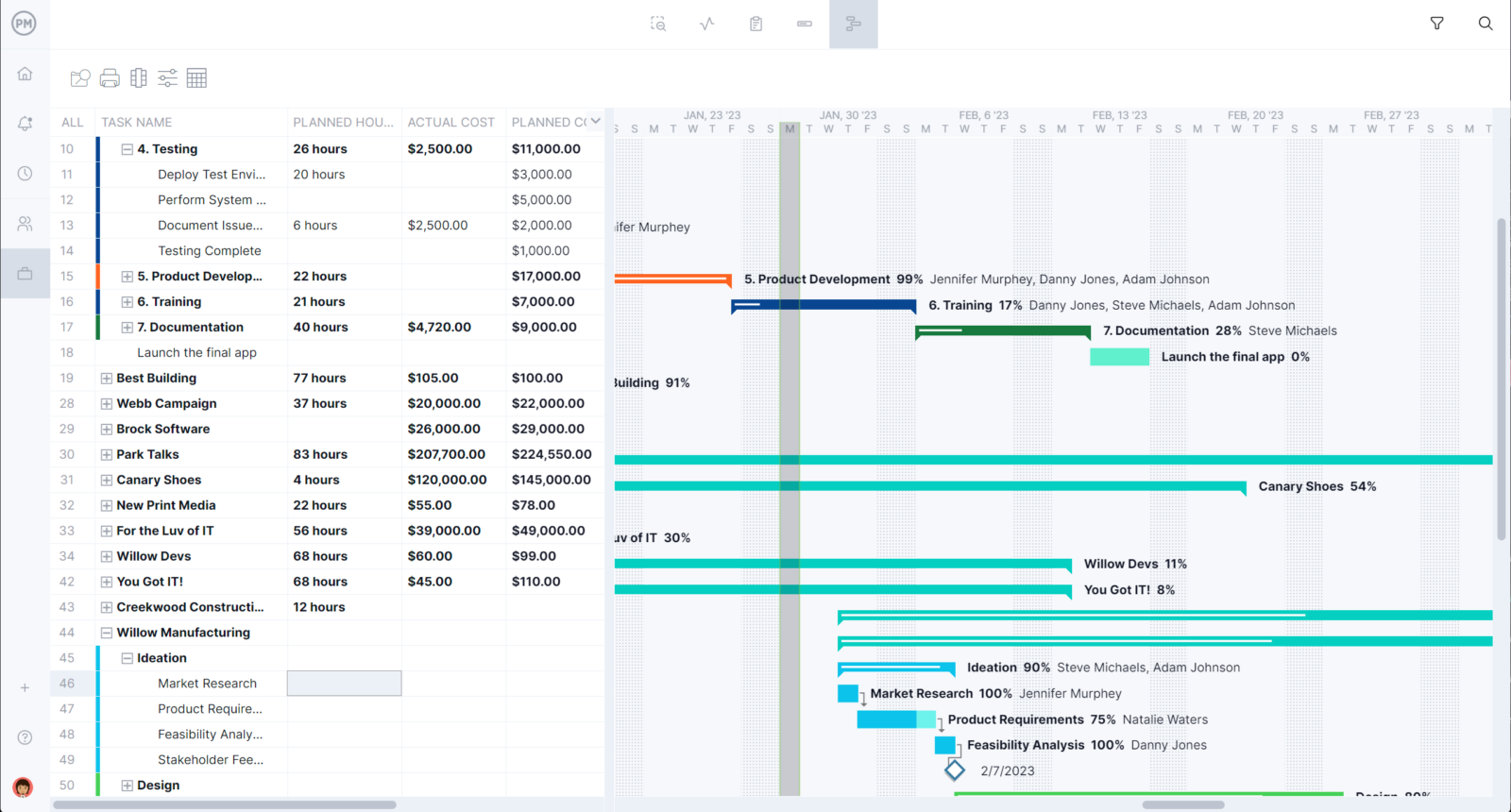
Kanban Boards
A product roadmap shouldn’t be just a document, but rather a work management tool that helps manage the product development process. ProjectManager’s kanban boards, for example, allow you to plan, schedule and assign tasks to your team members so you can execute the work that’s planned on your product roadmap.
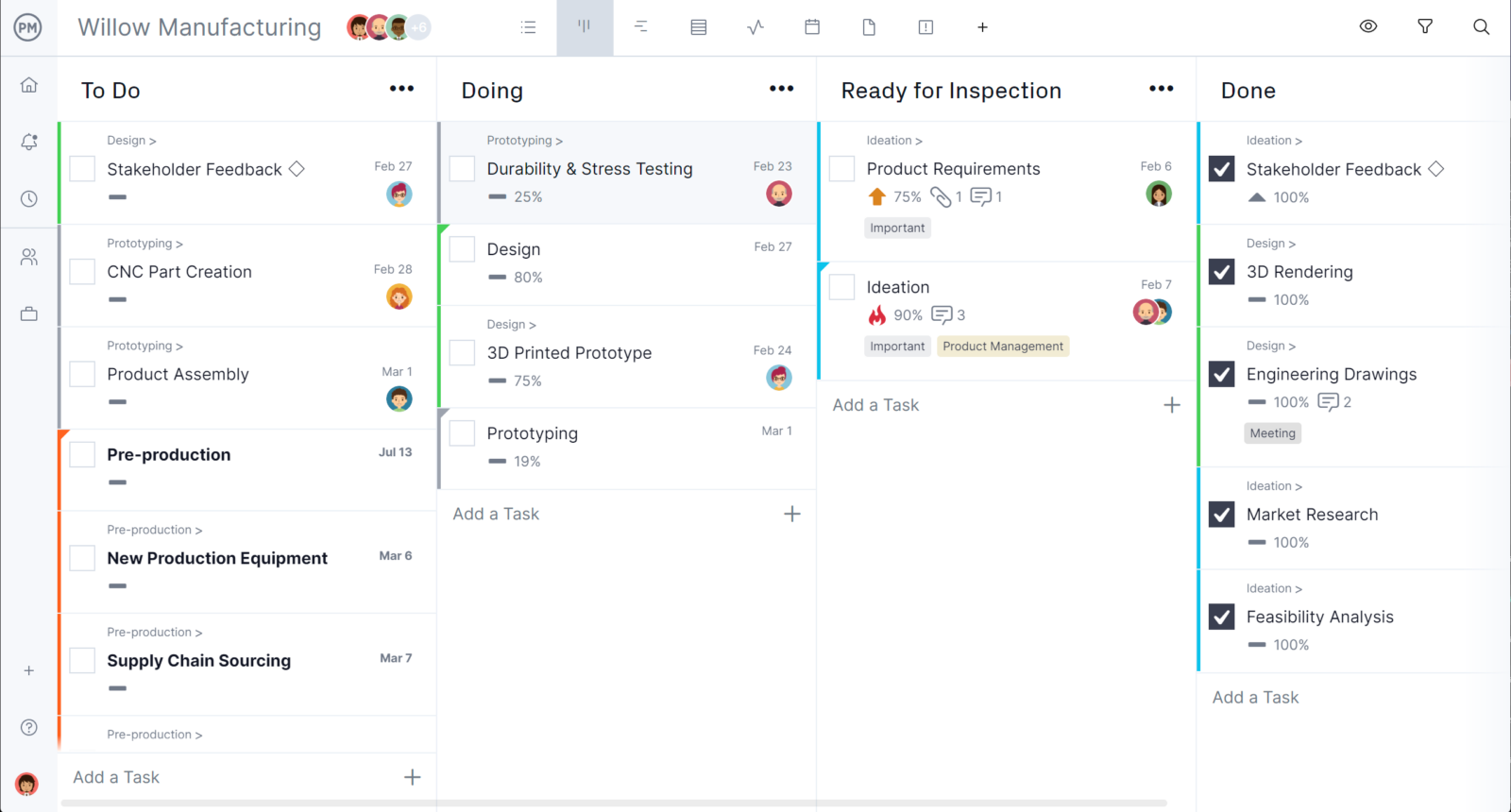
Dashboards
One of the most important aspects of managing a product roadmap is monitoring the team’s progress and tracking the cost of manufacturing products. ProjectManager automatically calculates the labor costs of the product roadmap activities based on the team member’s pay rate and the total work hours assigned to them.
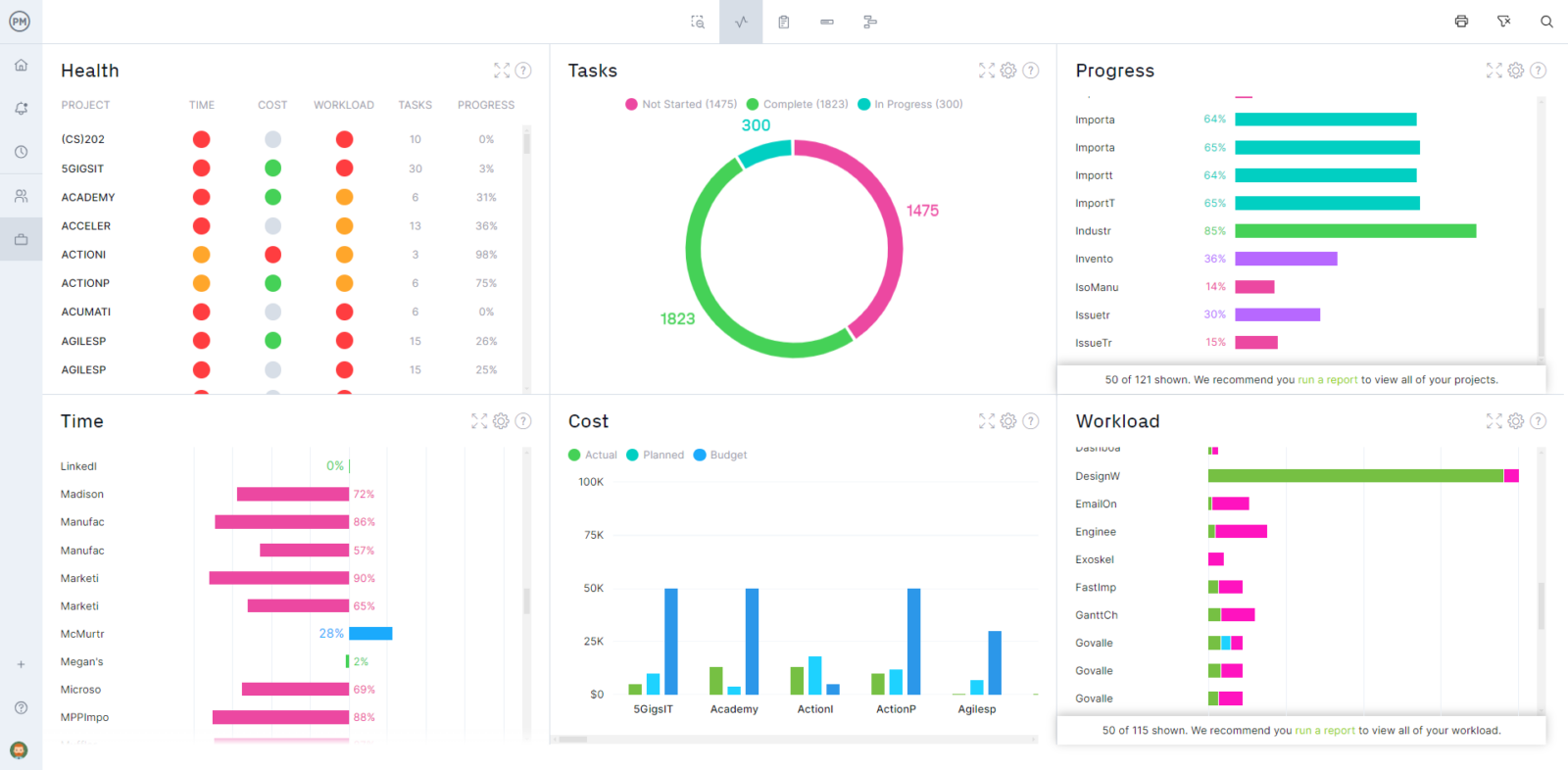
Workload Charts
Understanding how work is allocated is critical for making an accurate product roadmap. ProjectManager’s workload management chart monitors the number of hours employees are scheduled to work to better understand resource availability and determine if workload allocation is balanced or whether some team members are over or underallocated.

Product Roadmap Templates
Here are two free product roadmap templates to get started with the product roadmapping process. One makes an online Gantt chart product roadmap using ProjectManager, which has advanced planning, scheduling and tracking features. The other is a free product roadmap template for Excel, which is a simpler format that visualizes the activities to be executed over a timeline.
With ProjectManager’s Gantt Charts, you can create product roadmaps to keep track of user stories, epics, resources, your team’s workload and much more! Get started today with our free 30-day trial.
Online Product Roadmap Template
If using a product roadmap template might be too complex, we have a nice alternative to help you create one. Our product development template has a product roadmap sample. All you need to do is easily customize its fields to reflect your product development process.
Product Roadmap Template for Excel
This free product roadmap template for Excel maps all the steps of a product development process in a Gantt chart format. Simply list the tasks and adjust the bars’ sizes to represent their estimated duration. Then color-code the tasks and assign them to team members.
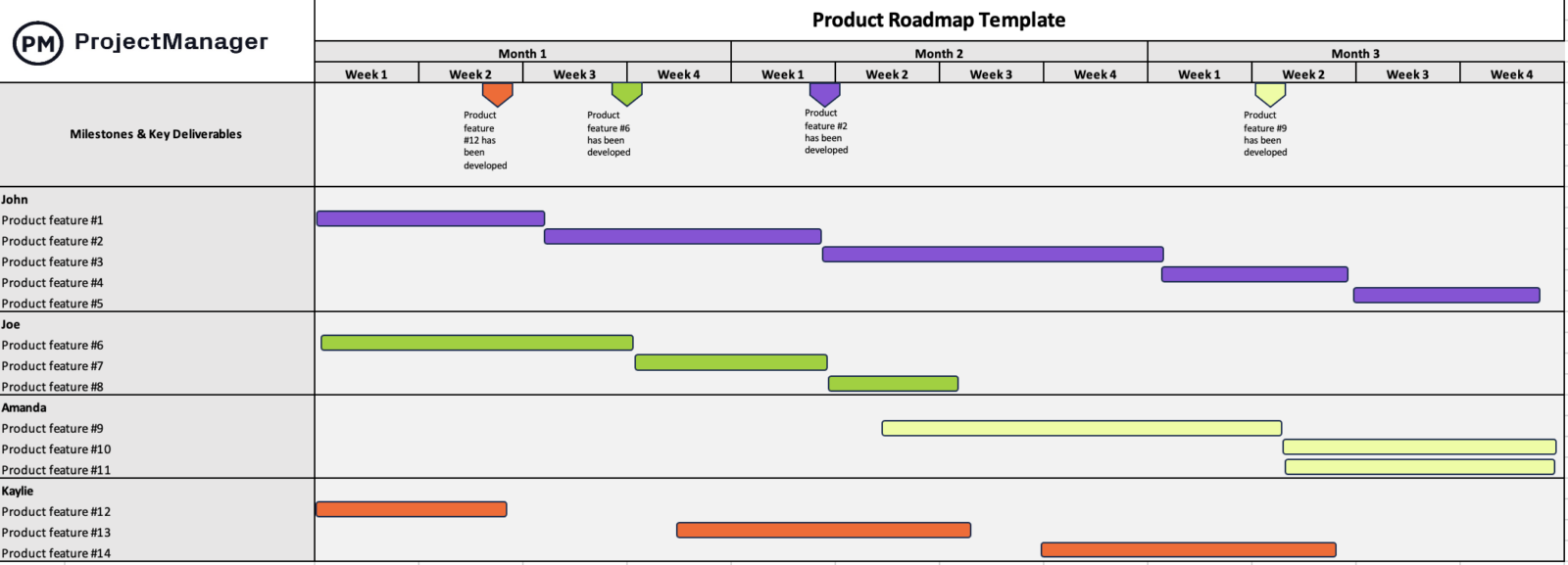
You can also identify milestones, which are important achievements that can help you quickly summarize the progress of your product development process.
Types of Product Roadmaps
Here’s a quick overview of some of the most common types of product roadmaps to get a better idea of the main advantages and disadvantages of these approaches.
Feature-Based Product Roadmap
As its name suggests, this type of product roadmap uses a visual timeline to show the time it takes to make each product feature, until a finished product with all the features is created.
Agile product development teams, for example, refer to product features as user stories, which are developed one by one during sprints and represented in product roadmaps commonly created using kanban boards and Gantt charts.
Goal-Oriented Product Roadmap
Essentially, a goal-oriented product roadmap works similarly to a feature-based product roadmap. However, a goal-oriented product roadmap is one of the simplest types of product roadmap because it doesn’t visualize each product feature or user story on the product roadmap timeline. Instead, it adds several product features into goals, which are easier to track.
Outcome-Based Product Roadmap
Instead of focusing on product features or product development goals, an outcome-based product roadmap timeline will show the outcomes from all the activities needed to develop a product.
Related: Free Product Development Template
In this product roadmapping method, the main priority is to let employees know what needs to be done, the expected outcomes and the estimated timeline.
Product Portfolio Roadmap
You may create a product portfolio roadmap to track the progress of the development process of multiple products or projects in a program or portfolio with only one tool, which is ideal for manufacturers with large product portfolios or extensive research and development R&D efforts. You may choose your product portfolio roadmap to be feature, goal or outcome-based.
Agile Product Roadmap
Agile is a project management methodology that can also help product and software development teams plan, schedule and track their activities. In an agile method, work is planned and executed in short iterations of time (known as sprints) to deliver product features, which are referred to as user stories because they’re product features described from the user’s standpoint and not the manufacturer’s.
While agile teams typically plan their sprints and track the completion of tasks using kanban boards, they still use Gantt charts or other timeline tools to visualize the total timeline of their product roadmaps.
Key Elements of a Product Roadmap
As stated above, product managers need to know how to create and manage a product roadmap. This requires understanding the essential elements of a product development roadmap.
- Product Strategy: This refers to the planning process of researching the market, setting business goals, creating a product vision and developing a product based on customer and stakeholder feedback.
- Product Vision: Just as with a company’s vision statement, your product vision describes what your company intends to achieve with this product, what is the core value proposition, and the main product benefits.
- Goals & Objectives: In product management, goals are high-level statements that give a larger context to the product in terms of what it’s trying to achieve. Objectives are more specific and result in tangible deliverables such as product features.
- Strategic Initiatives: Strategic initiatives are a group of related user stories needed to complete specific goals. There can be several initiatives being executed simultaneously in a product roadmap.
- Product Releases: A product release is the launch of new features, completion of user stories, epics and other additions to an existing product.
- User Stories: In product management, a user story is simply a product feature, only described from the user’s perspective so that the product development team better understands what needs to be done.
- Epics: An epic is a user story that is too complex to be done in a single product release. Epics need to be broken down into several user stories that are easier to develop by the product team.
- Timeline: One of the main purposes of a product development roadmap is to track progress. That’s why product roadmaps should include a timeline that defines due dates and milestones.
- Product Development Status: Your product roadmap should have status indicators and metrics to determine the percentage of completion of tasks, goals, user stories and epics.
Product Roadmap Best Practices
Besides picking the most convenient type of product roadmap and the right tools to create one, there are many other things to consider. Here are some best practices that will help the product roadmapping process.
- Set Measurable Goals and Objectives: Set goals and objectives that can be measured using KPIs, OKRs and other performance management metrics.
- Promote Collaboration and Communication: There are likely many teams, and certainly different people and departments, all working together to create the product. Therefore, the product roadmap must facilitate that collaboration through clear communication of the overall product strategy and keep everyone on the same page.
- Align with Corporate Objectives: The high-level view of a product roadmap is designed to dovetail with the overall objectives of the corporation to make sure the product is aligned with where the company is going. (Read more about aligning projects to strategy.)
- Leave Time to Learn and Research: This graphic view of the schedule, which is laid out from left to right, must also include whatever research and learning curve is needed to make sure everyone on the product team is knowledgeable about what they’re doing and how they’re doing it.
Benefits of Using a Product Roadmap
It should be obvious that a product roadmap is a great tool to ensure that everyone knows what the product is about, how it’ll be executed and who’s doing what. But it never hurts to reinforce the benefits for a little extra motivation.
Fast Communication
The product roadmap is a great way to quickly communicate the product strategy and goals at a high level and with visual clarity that makes it easy to understand for everyone. This includes managing the expectations of stakeholders as well as communicating with all other important parties. A product roadmap is a living document and should be updated regularly, so it’s a great tool to send to anyone in the product group or customers to keep them updated on progress.
Keeps Decisions Grounded
As constraints and variables occur, the product roadmap keeps your decision-making tethered to the goals and objectives of the product, so you can prioritize tasks and make decisions quickly and accurately.
ProjectManager Is the Best Product Roadmap Tool
Many tools can help one create a product roadmap, from the simple to the more dynamic. Because the product roadmap is a visual tool, though, it’s not something that can be slapped together on a Word document or even a spreadsheet.
However, a spreadsheet can be a good place to collect all the information needed to go into the product roadmap. There are software solutions that can take that raw data and import it to display on a visual timeline. ProjectManager imports spreadsheets and instantly creates a Gantt chart, which is a visual timeline.

The Gantt chart will display all the milestones of the product, the tasks will be points on the timeline with lines across that timeline to indicate the duration of the tasks. If any tasks depend on one another, they can be linked. All of which offer a graphic and clear overview of the product.
For a different visual expression of the product, there are Kanban boards. Kanban is a scheduling system for lean manufacturing where columns are created and under which tasks that are related are collected, which are called Kanban cards. These cards can then be moved across the board to indicate where they are in the process.
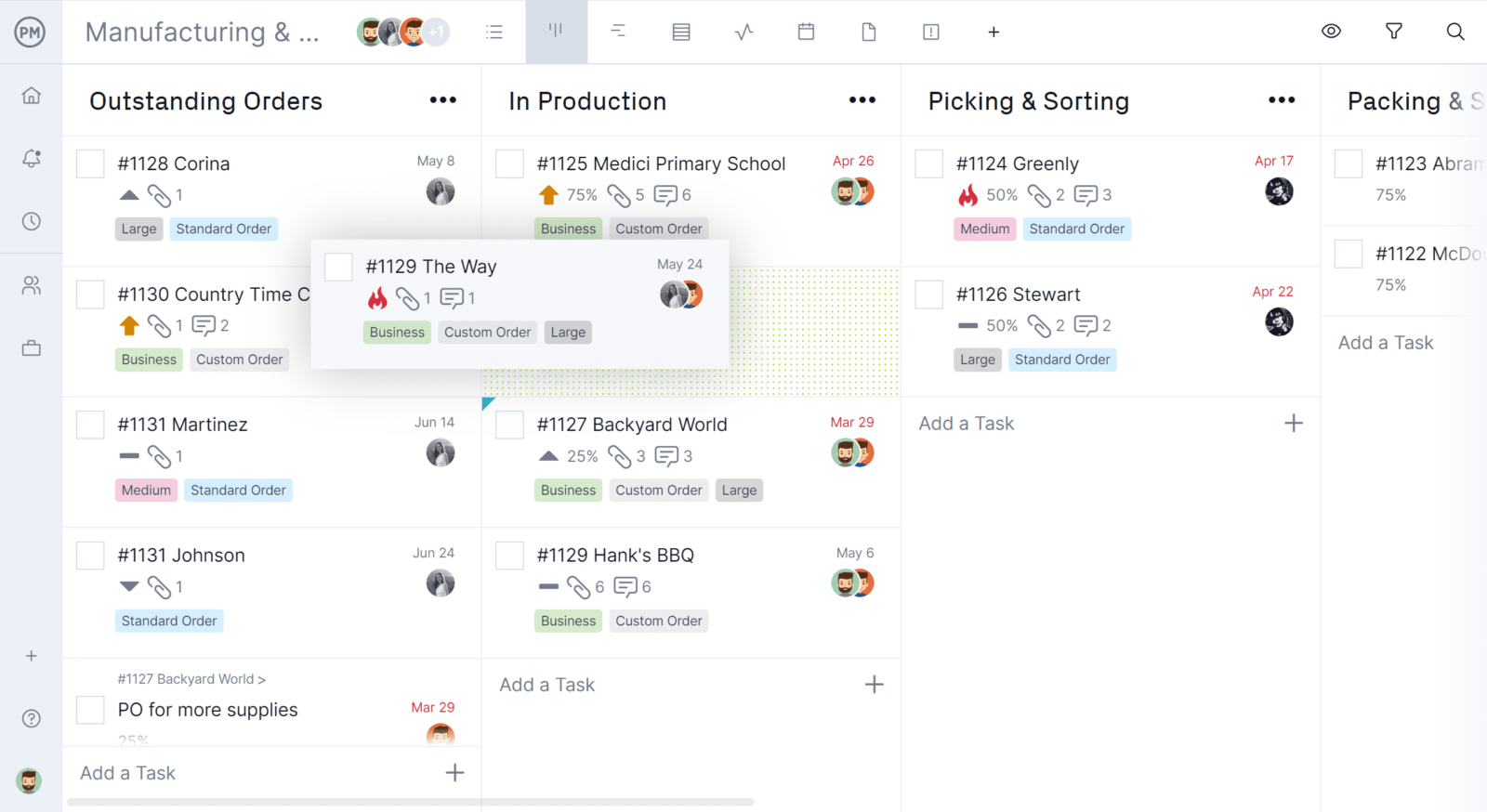
Both product roadmaps are features of ProjectManager, but they’re only part of the tools provided by the software. With ProjectManager, the product roadmaps are online and easy to convert and share. They’re living documents that update in real-time and offer collaborative tools to keep teams communicating effectively. The real-time dashboard can filter data and make it into charts and graphs. It’s like having a product roadmap fueled with octane.
The product roadmap is one of the many essential documents that help start and keep product management on track. ProjectManager is online project management software that has features to create product roadmaps in a visual style that works with your product. Plus, it offers tools that take that product roadmap to the next level. See how it can help you by taking this free 30-day trial.

